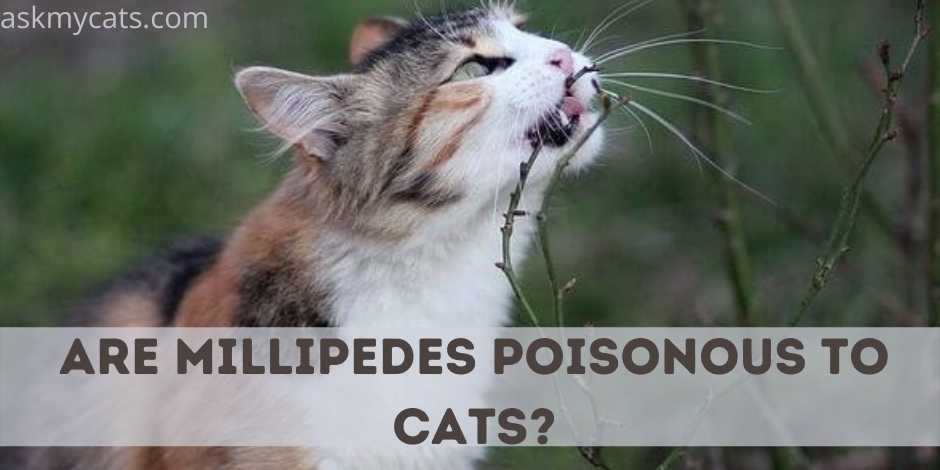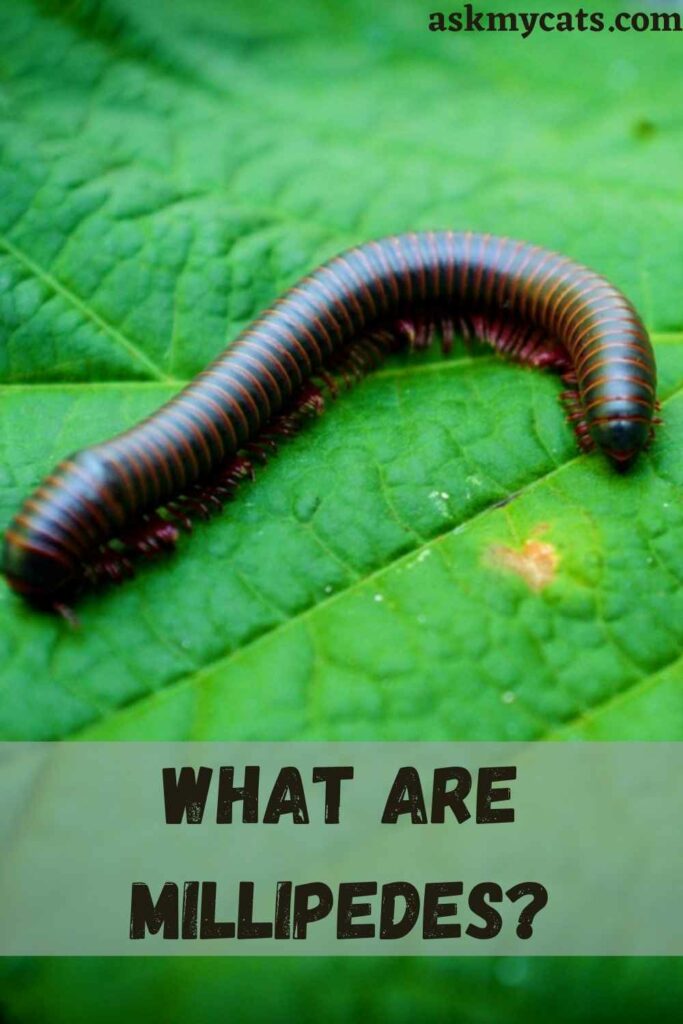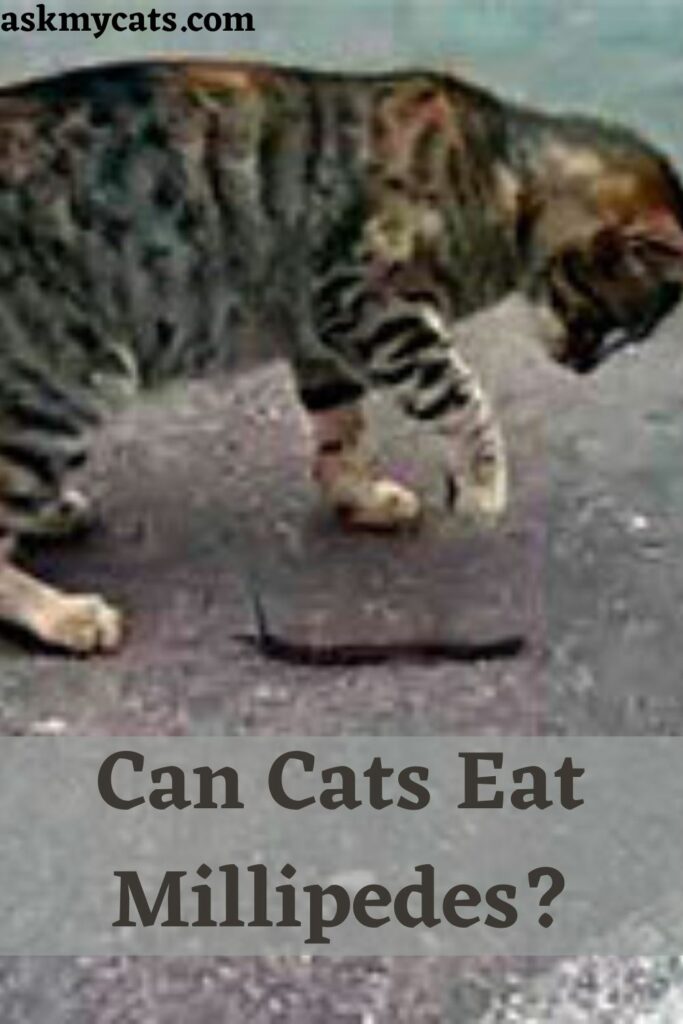If your cat has access to the outdoors, she’s probably come across insects like ladybugs and arachnids like spiders. She may also chase and catch wriggly arthropods like millipedes, which she finds to be excellent prey.
However, because these wrigglers release secretions that are hazardous to animals, this could be concerning.
Millipedes are a group of arthropods that have two pairs of jointed legs on most of their body segments; they belong to the Diplopoda class, which gets its name from this trait. Two single segments are fused together to form each double-legged segment.
So, are millipedes poisonous to cats?
No, millipedes are not poisonous to cats, nor do they bite. Some species, however, produce defence secretions that irritate or burn your cat’s eyes and skin. Hydrochloric acid, organic acids, phenol, cresols, hydrogen cyanide, benzoquinones, and hydroquinone are among the compounds found in the fluids.
Keep reading this article to know if millipedes are poisonous to cats and what you can do about them.


Give Your Cat the Perfect Day
Get the Free Ebook!
What Are Millipedes?
Millipedes are a group of arthropods that are characterised by having two pairs of jointed legs on most body segments; they are known scientifically as the class Diplopoda, the name derived from this feature.

The millipede is a member of the arthropod phylum, which includes spiders and butterflies.
They are not considered insects, despite having a hard exoskeleton that protects their body.
Though some millipede species are poisonous, they have little defense against natural predators.
They have no pinchers, stingers, or claws to deter predators, and they don’t even bite.
They will, at most, release a toxin that has an effect similar to an allergic reaction.
Despite their name, millipedes do not have a length of 1,000 feet. Instead, they have 100 legs on average, with a maximum of 750 legs.
According to the findings, the millipede was the first animal to walk on land 400 million years ago. One millipede’s ancient relative grew to be 7 feet long!
The millipede moults as it grows. These moulting sessions allow them to grow additional legs each time when they are young.
There are potentially 80,000 species of these animals alive today, but researchers and scientists have only identified 12,000. The millipede’s heart is located throughout the body, and the aorta is located at the head.
You should not be worried if your cat happens to eat a millipede as they are not poisonous to them. They can cause vomiting and stomach ache in cats if the defensive fluid is released, although these symptoms should only last for a day or two.
Can Cats Eat Millipedes?
Yes, cats can eat millipedes as they are not poisonous, but they are not recommended as they can induce symptoms like vomit and discomfort.

If eaten, millipedes are not toxic.
On the other hand, your cat may have stomach discomfort if the millipede was releasing its protective fluid as she was eating it.
She will vomit, meow excessively, and be in pain, but these symptoms will subside within a day.
Eating millipedes is not a good idea for cats.
It’s also not a good idea for them to eat many other common bugs and insects, such as grasshoppers, flies, and even other arthropods like centipedes.
Millipedes do not have poisonous venom. They are mostly harmless creatures that do not pose a threat to cats’ lives.
When confronted with a threat, the creatures curl. As a result, they are relatively safe.
However, they should never be handled roughly because they can produce an irritating liquid as a defensive mechanism. The liquid is not poisonous, but it can be extremely irritating to the skin.
It shouldn’t hurt them unless the millipede has released some of its defensive liquid, as described above.
If this has occurred, there should be some obvious signs. If your cat has ingested some of the fluid, it will either paw at the area on its body where it landed or showed signs of having an upset stomach.
And, if you suspect your cat ate one, keep a close eye on it for the next day or so, hoping it has learned its lesson from the stomach ache.
What Happens If A Cat Eats A Millipede?
If a cat eats a millipede, it can show symptoms such as vomiting and an upset stomach if the millipede had released its defensive liquid before being consumed.

Millipedes are not poisonous if consumed by your cat. This doesn’t mean your cat won’t get an upset stomach; eating large arthropods can cause discomfort.
It will be even more unpleasant if the millipede produces some of its defensive liquid while the cat is eating it.
Millipedes feature a long, segmented body with an exoskeleton, a pair of antennae on the head, and a large number of legs, ranging from 40 to 400 pairs.
There are about 7,000 different species of these arthropods, some of which are dark brown or black in color, while others are brightly colorful but toxic.
They are slow-moving, do not bite, and range in length from half an inch to six and a half inches.
Their major defense strategy when provoked is to curl into a tight coil to protect their vulnerable legs.
When they are seriously threatened, such as when a cat swats and bites them, their glands release a chemical fluid spray that irritates them. Millipedes can spray fluid up to 80 cm, causing eye burns, irritation, and coloring of the skin.
If this occurs, your cat may begin to exhibit one or more of the following symptoms:
- Vomiting
- Loss of appetite
- Meowing and discomfort
In most cases, these issues should resolve themselves within 24 hours. So, you shouldn’t be too concerned, but that’s easier said than done.
However, if you notice anything that concerns you, or if the problems persist for more than a day, get your cat checked out by a vet just to be safe.
Another question is whether a millipede can harm a cat when it is defending itself from an overly playful kitty knocking it around and chasing it as prey.
Millipedes do not bite, at least not hard enough to be painful. When they feel threatened, their main defensive strategy is to spray the liquid.
You’ve probably seen this before; it’s not uncommon with bugs and insects. The good news is that, like most common bugs, it is not dangerous, but it does stink!
If you’re wondering why they do this, it’s because this liquid is toxic to some small insects and bugs that they need to defend themselves against in the wild. However, cats, humans, and other large animals are not affected.
If your cat gets a good dose of their chemical spray while playing with them, you may see him or her:
- Rolling around in the dirt to try and rub the scent off
- Meowing and making noise as they are distressed
- Pawing and licking the area where the spray landed
- Pacing around being agitated
The effects and smell should only last about an hour. You can clean the area by rinsing it with cold water or using pet wipes.
Can Millipedes Bite Cats?
No, millipedes do not bite cats as their primary defence mechanism is curling into a tight coil in order to protect their delicate legs inside the hard body exterior.
Millipedes are not poisonous creatures. They move slowly and primarily feed on the decomposing vegetative matter and other organic materials.
Even when threatened, the creatures do not bite. Their primary defence mechanism is curling into a tight coil to protect their delicate legs inside the hard body exterior.
Unless severely provoked, they remain harmless unless they produce an irritating liquid to splash on the enemy.
Millipedes are not vicious creatures. Unless they are threatened, they are harmless. When arthropods face a specific threat, they activate their innate defensive mechanisms. They have glands that produce special fluids with a stinging effect.
Millipedes can spray the venomous liquid up to 80 cm away. Chemical fluid sprays can cause a variety of skin irritations and, in the long run, skin discoloration in your cat.
It is critical to understand that this is only a defensive mechanism used by millipedes when they are threatened. As a result, you should always avoid letting your cat near the millipedes in such a way.
Can Black And Yellow Millipedes Kill Cats?
No, black and yellow millipedes are unable to kill cats as they are not poisonous.
The black and yellow millipedes are among the most prevalent arthropod species. These millipedes, like all other millipedes, are not poisonous.
They twist their bodies in response to their threat. When the threat becomes too much to handle, these organisms elicit the production of an irritating fluid from their glands.
Hydrochloric acid is the main component of the fluid, and it has the potential to burn and discolour your cat’s skin. These species may spray the irritating liquid up to 80 cm away (Approximately 32 inches).
The two arthropods are generally friendly and non-poisonous. They only defend themselves against external aggression when it is absolutely necessary.
Millipedes are frequently preyed upon by cats and birds. Bird rearing is a fantastic technique to keep millipedes at bay.
Some cats, however, are allergic to the irritating protective fluid that millipedes emit. They react by becoming agitated, losing their appetite, and becoming drowsy.
Millipedes do not harm human beings. However, the creatures can cause a lot of discomfort among your cats. This is a particularly serious issue if you have kittens at home.
Arthropods have a bloodcurdling anatomy, with a high number of appendages and a heavily segmented body. As a result, you should chase them out of the house.
Frequently Asked Questions
Are millipedes and centipedes the same?
No, millipedes and centipedes are not the same. Centipedes are terrestrial arthropods of the Chilopoda class. Centipedes are dorsoventrally flattened flexible arthropods. Millipedes, which belong to the Diplopoda class, are more stiff arthropods with a subcylindrical form. Millipedes have two pairs of legs per body segment, while centipedes have one pair per body segment. Millipedes move slowly and burrow, unlike centipedes, which are famed for their speed.
What attracts millipedes in the house?
Millipedes prefer to hide in moist, dark locations while they’re out in the open. They will sometimes seek cover inside your home if the weather outdoors becomes too hot, dry, or wet from heavy rain—millipedes like cool, moist environments indoors, such as the basement, crawl areas, or garage.
What insects can cats eat?
When your cat eats moths and butterflies, they are not poisonous. Their fluttering has the ability to hypnotize any cat, making them easy prey. Ingesting flies and fleas are a regular occurrence for your cat. In the summer, chasing flies is extremely typical since they try to bite your cat’s ears.
Final Words
Cats are curious creatures who enjoy chasing fluttering and wriggly creatures. Millipedes, like beetles and butterflies, attract them because of their movement and size. While millipedes are not harmful to cats, they can cause stomach discomfort as well as chemical burns to the eyes and skin.
So, while it’s not a big deal if you find your cat eating one, however, if the symptoms of vomiting and stomach ache persist for more than two days, you should seek medical help.
If you have any unanswered questions feel free to ask us in the comments section.
